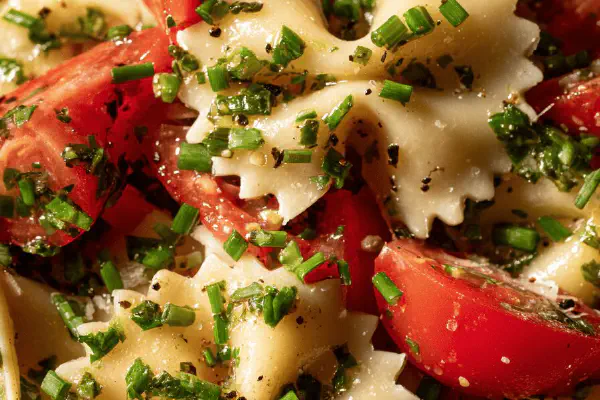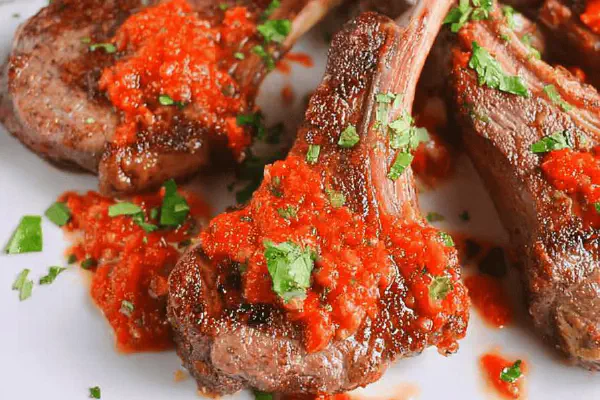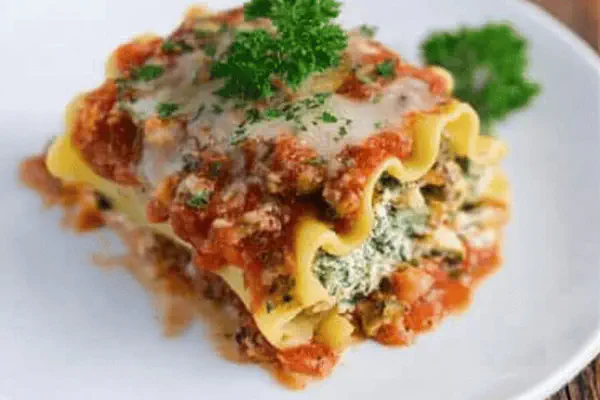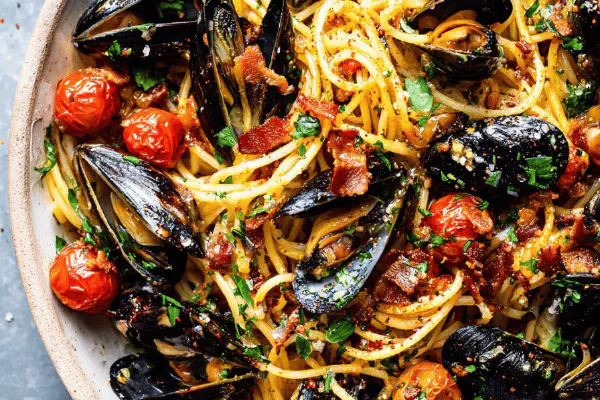Pasta with Roasted Peppers and Asparagus
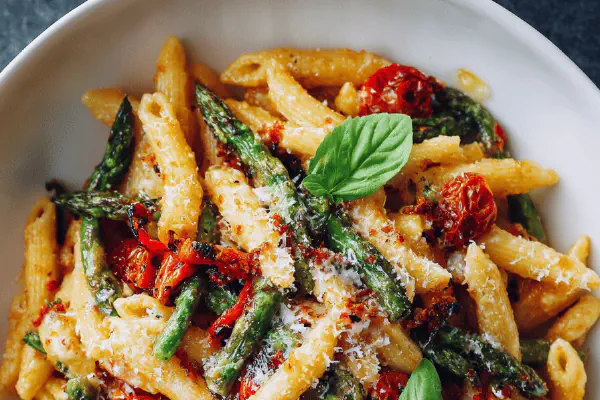
By Emma
Certified Culinary Professional
Ingredients
- 3 red bell peppers, seeded and diced
- 2 shallots, finely chopped
- 3 cloves garlic, minced
- 60 ml (1/4 cup) olive oil
- 5 ml (1 tsp) spicy harissa paste
- 375 g (approx 13 oz) short pasta like penne or rigatoni
- 400 g (14 oz) asparagus, trimmed and cut into 2.5 cm segments
- 150 g (1 cup) cherry tomatoes, halved
- 80 g (cup) grated pecorino romano cheese
- Fresh basil leaves, torn (optional)
- Salt and freshly ground black pepper
About the ingredients
Method
- Heat a large nonstick skillet over medium heat. Pour in olive oil. Once it shimmers, add the diced bell peppers and shallots. The pan will start to whisper soft sizzling sounds—cook gently for about 12 minutes, stirring often. Look for the shallots to turn translucent and peppers to soften and begin caramelizing at edges. Do not rush—this builds a deep, sweet base.
- Add minced garlic and cook for another 2-3 minutes until fragrant but not burnt. Sprinkle salt and pepper here. Spoon in the harissa; stir well to combine. The aroma will intensify, spicy and smoky. Lower heat slightly to prevent any bitter burnt notes.
- Meanwhile, bring a large pot of well-salted water to a rolling boil. Add pasta and cook until just shy of al dente—taste frequently after 7 minutes. When about 2 minutes remain, toss asparagus pieces and cherry tomatoes into the pot. The asparagus should stay vibrant green and snappy, tomatoes slightly softened but not mushy.
- Reserve 180 ml (3/4 cup) pasta water just before draining. Drain pasta, asparagus, and tomatoes together. Immediately return everything to the pot to keep heat.
- Pour the pepper mixture into the pasta. Add the reserved pasta water gradually, stirring to coax a glossy sauce that clings to each piece of pasta. Toss in pecorino cheese and gently fold to combine. Season again with salt and pepper to taste. Toss in fresh basil just before serving for a fragrant lift.
- Serve piping hot. Watch cheese melt slightly, coating pasta in savory richness balanced by bursts of tender asparagus and sweet tomatoes.
Cooking tips
Chef's notes
- 💡 Diced peppers slow cook in oil till edges caramelize not charred smells sweet and deep. Watch shallots turn translucent hint softness not browned or raw. Stir often but let the pan quiet down between. That gentle sizzle speaking readiness. Garlic added late so it gets alive but never bitter. Timing by smell not clock avoids burnt garlic ruining savory base.
- 💡 Harissa paste added near end keeps smoky spice fragrant not overcooked or bitter. Adjust heat here if sensitive swap smoked paprika or less paste. Use salt carefully late stage so flavors don’t dry out sauce. Pasta water reserved thick with starch, crucial for sauce cling; don’t skip it. Stir in gradually coax glossy shine coating penne not pooling oil or clumps of cheese.
- 💡 Pasta cooked shy of al dente then asparagus with tomatoes added last two minutes keeps snap and color vibrant. The tomatoes soften just enough to burst acidity but never mush. Toss everything hot return to pot quickly after draining retains heat and melds flavors. Avoid overcooking asparagus, no sogginess. Pasta water temp matters here too, residue heat keeps sauce silky.
- 💡 Cheese choice gives character; pecorino sharp and salty edge, parmesan milder. Vegan swaps like nutritional yeast break tradition but work if avoiding dairy. Add cheese slowly fold gently to avoid clumps or graininess, melting best combining warm sauce and pasta together. Basil torn just before serving releases fresh oils instantly, sudden aroma burst lifts entire dish at the finish.
- 💡 Oil amount dialed down to just coat pan, peppers absorb instead of swimming. Slow caramelization avoids greasiness, builds natural sweetness. Asparagus trimmed just above woody ends retains crunch no bitter fibrous bits. Salt late to balance flavors but incremental tasting recommended. Rely on sensory cues: sound, smell, texture, visual hints over timers for best layering of flavors.
Common questions
Can I use onion instead of shallots?
Yes but sharper flavor. Longer softening needed. Shallots bring sweetness less bite. If onions used, cook slow longer till very soft. Changes base flavor but still works.
What if no harissa paste?
Substitute smoked paprika with chili flakes. Or mild chili sauce. Harissa gives smoky heat layering but alternatives keep fire mild. Avoid overpowering or bitter if cooked too long. Add gradually, taste frequently.
How to fix mushy asparagus in pasta?
Overshoot cooking time. Blanch then shock in cold water before adding. Or toss in last minute raw for crunch. Cook with tomatoes briefly only so they soften but asparagus stays vibrant and crunchy, not soggy.
Leftovers store how?
Refrigerate in sealed container up to 3 days. Reheat gently with splash of water or extra oil. Avoid microwave overheat or cheese seize up. Can freeze but texture changes; asparagus softens after thawing.
